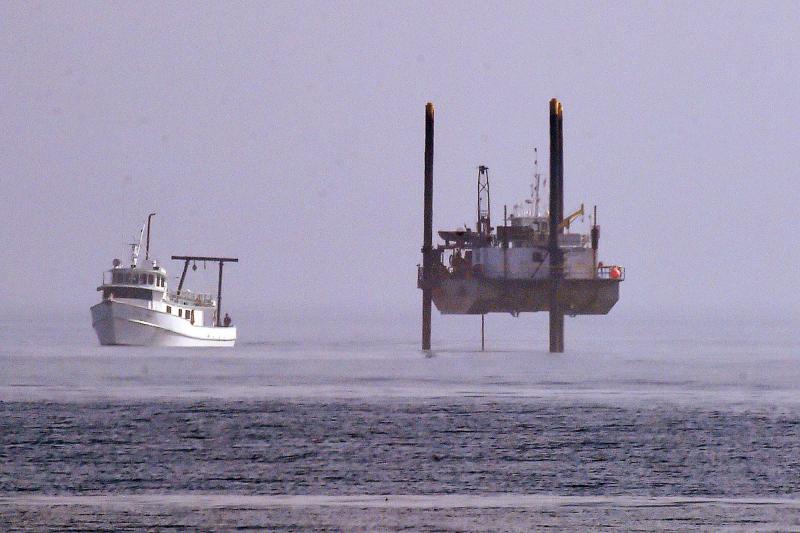In Rehoboth, ocean surveying begins for outfall
The recent patch of bleak, rainy weather has delayed field testing work on Rehoboth Beach's $52.5 million ocean outfall project.
Kelvin George, project manager for engineer GHD, said the barge from which soil borings are being taken was damaged by recent storms and had to be brought to shore for repairs. He said the barge should be back out again soon to complete work.
City Manager Sharon Lynn said the information from the samples will be used to develop permit requests and construction documents.
Mayor Sam Cooper said crews are testing to determine the water depth along the route where the outfall pipe will be placed, checking for metals from shipwrecks, testing sediment and sand, taking soil samples from the ocean floor and drilling holes at different depths to determine the sturdiness of the sand on the ocean floor.
George said the soil borings are being taken at depths down to 75 feet. The samples are being used to determine the characteristics of the soil below the ocean floor. That information will be used to determine how deep the outfall pipe needs to be, George said.
The outfall pipe will ultimately go 6,000 feet off the shore of Deauville Beach. George said additional tests have been conducted at 2,000 feet and 4,000 feet from the shore to determine how far out the outfall pipe can be directionally drilled. George said directional drilling is preferred since it does not disturb the ocean floor.
However, directional drilling can only go 4,000 feet out, George said. He said how the pipe will go the full 6,000 feet out is still to be determined. Cooper has suggested possibly directionally drilling 3,000 feet from the shore. A second 3,000 foot section of pipe would then be drilled from a barge in the ocean and the two sections would be linked together.
At the end of the pipe will be a diffuser that will disperse the treated effluent from the city's wastewater treatment plant. The diffuser acts like a sprinkler and is located above the ocean floor. George said the exact design of the diffuser has yet to be determined. Nearby South Coastal Regional Wastewater Treatment Plant in Bethany Beach has a Y-shaped diffuser. How the diffuser is constructed will partly be based on the soil sampling, George said, as the testing will reveal if the diffuser has to be anchored into the ground by pilings if the soil is not sturdy enough.
Lynn said GHD has been performing survey work for permits required by the state and federal governments since August. She said work would continue through most of 2016, with most of the surveying taking place along the route of the force main that is planned to run from the city’s wastewater treatment plant, down Henlopen Avenue and out at the diffuser site.
Cooper said the city’s permits are pretty much ready to go, with the results from the sampling still to be plugged in; the city would not know the results until a month or so after GHD wraps up the ocean work, he said.
The city’s permitting process is being handled in conjunction with Delaware Department of Natural Resources and Environmental Control, and Cooper said once the permits are ready, they will be subject to a public hearing process, similar to the one DNREC conducted for the city’s environmental impact statement that was required for state funding for the project.
Ultimately, Cooper said, work is expected to begin in the fall of 2017. In addition to permitting, pre-construction work includes lining up a contractor for the ocean work. Cooper said he expects the city commissioners to develop a shortlist of contractors this fall.
The ocean work is very specialized, Cooper said. Interested contractors will likely be asked to submit pre-bid qualifications; Cooper said he hopes to select a winning bidder this winter. After that, there is a long delay necessary for the contractor to obtain environmental permits and mobilize equipment.
Cooper said the city also plans to give prospective contractors leeway during bid submissions to propose any cost-effective alternatives they may suggest. He said contractors for the ocean work typically work on oil rigs in the Gulf of Mexico, and with the downturn in the oil industry, city officials would like to strike while the iron is hot. Cooper said the variety of contractors now looking for work could help drive down the price of the project.
Ryan Mavity covers Milton and the court system. He is married to Rachel Swick Mavity and has two kids, Alex and Jane. Ryan started with the Cape Gazette all the way back in February 2007, previously covering the City of Rehoboth Beach. A native of Easton, Md. and graduate of Towson University, Ryan enjoys watching the Baltimore Ravens, Washington Capitals and Baltimore Orioles in his spare time.


























































